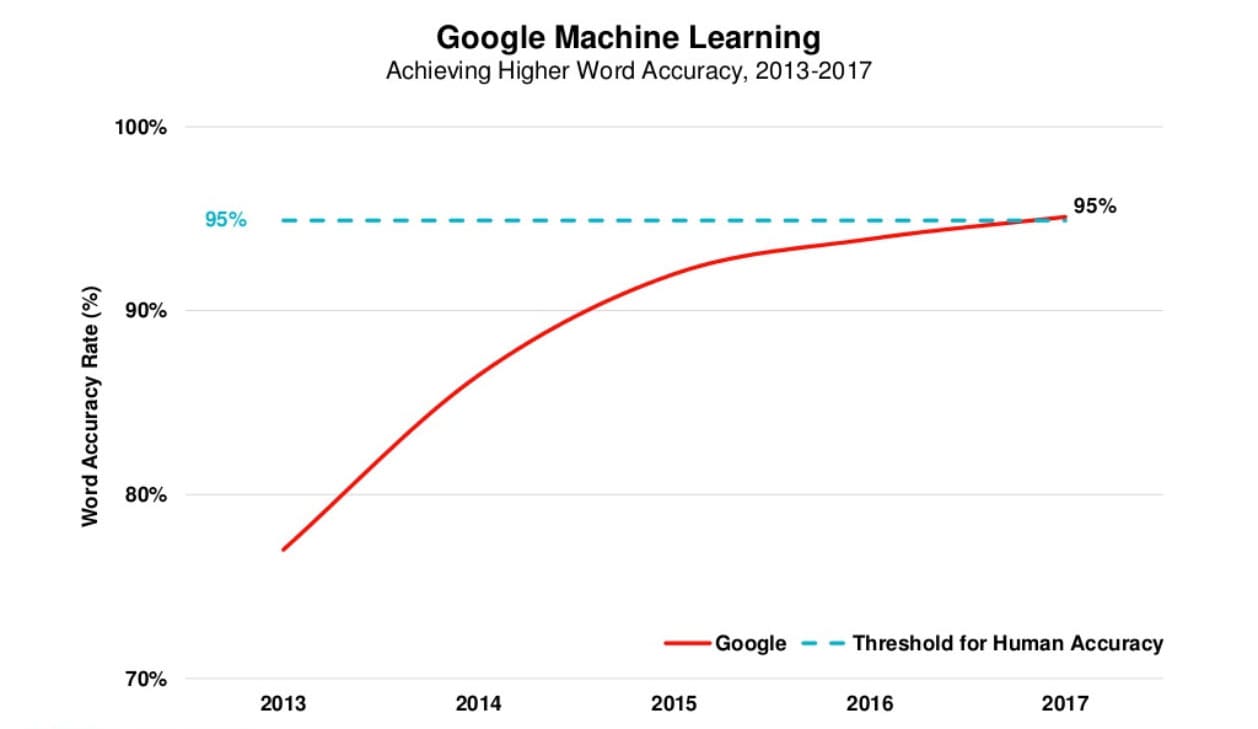Introduction 
Computing power and artificial intelligence are largely behind the advances in this space. With massive amounts of speech data combined with faster processing, speech recognition has hit an inflection point where its capabilities are roughly on par with humans. The graph below is from Mary Meeker’s 2017 Internet Trends report (edit: no longer available on Slideshare). It plots Google’s word accuracy rate which recently broke the 95% threshold for human accuracy.
While there have been a ton of strides lately, voice recognition dates back to the early 1950s. Below are some of the key events that shaped this technology over the last 70 years.
1950s and 60s 
The first speech recognition systems were focused on numbers, not words. In 1952, Bell Laboratories designed the “Audrey” system which could recognize a single voice speaking digits aloud. Ten years later, IBM introduced “Shoebox” which understood and responded to 16 words in English.
Across the globe other nations developed hardware that could recognize sound and speech. And by the end of the ‘60s, the technology could support words with four vowels and nine consonants.
1970s 
Speech recognition made several meaningful advancements in this decade. This was mostly due to the US Department of Defense and DARPA. The Speech Understanding Research (SUR) program they ran was one of the largest of its kind in the history of speech recognition. Carnegie Mellon’s “Harpy’ speech system came from this program and was capable of understanding over 1,000 words which is about the same as a three-year-old’s vocabulary.
Also significant in the ‘70s was Bell Laboratories’ introduction of a system that could interpret multiple voices.
1980s 
The ‘80s saw speech recognition vocabulary go from a few hundred words to several thousand words. One of the breakthroughs came from a statistical method known as the “Hidden Markov Model (HMM)”. Instead of just using words and looking for sound patterns, the HMM estimated the probability of the unknown sounds actually being words.
1990s 
Speech recognition was propelled forward in the 90s in large part because of the personal computer. Faster processors made it possible for software like Dragon Dictate to become more widely used.
BellSouth introduced the voice portal (VAL) which was a dial-in interactive voice recognition system. This system gave birth to the myriad of phone tree systems that are still in existence today.
2000s 
By the year 2001, speech recognition technology had achieved close to 80% accuracy. For most of the decade there weren’t a lot of advancements until Google arrived with the launch of Google Voice Search. Because it was an app, this put speech recognition into the hands of millions of people. It was also significant because the processing power could be offloaded to its data centers. Not only that, Google was collecting data from billions of searches which could help it predict what a person is actually saying. At the time Google’s English Voice Search System included 230 billion words from user searches.
2010s 
In 2011 Apple launched Siri which was similar to Google’s Voice Search. The early part of this decade saw an explosion of other voice recognition apps. And with Amazon’s Alexa, Google Home we’ve seen consumers becoming more and more comfortable talking to machines.
Today, some of the largest tech companies are competing to herald the speech accuracy title. In 2016, IBM achieved a word error rate of 6.9 percent. In 2017 Microsoft usurped IBM with a 5.9 percent claim. Shortly after that IBM improved their rate to 5.5 percent. However, it is Google that is claiming the lowest rate at 4.9 percent.
The future 
The technology to support voice applications is now both relatively inexpensive and powerful. With the advancements in artificial intelligence and the increasing amounts of speech data that can be easily mined, it is very possible that voice becomes the next dominant interface.
At Sonix, we can thank the many companies before us that have propelled speech recognition to where it is today. We automate transcription workflow and make it fast, easy, and affordable. We couldn’t do that without the amazing work that has been done before us.
Fast, accurate automated transcription 
Sonix automatically transcribes and translates your audio/video files in 53+ languages. Easily search, edit, and share your media files. Sonix is the best automated transcription software in 2025. Fast, accurate, and affordable. Millions of users from all over the world.
Includes 30 minutes of free transcription
Other Sonix articles 
Tips on how to capture great audio
Hear from other Sonix users about how they record high quality audio
Transcription software
Automated video to text: Convert your audio to text in a few quick steps!
Verbatim transcription
Use cases and benefits of verbatim transcription
Why should you transcribe?
Five reasons you should be transcribing your audio and video files
How much does transcription cost?
The price sometimes varies per hour, minute, or per word
History of speech recognition
How did we get to where we are today in speech recognition? Sonix explains
How to remove the metallic sound
The metallic, tin-like sound you hear in your audio is an unwelcome annoyance
Remove background audio noise
Background noise is annoying and lowers the accuracy of your transcript
Remove background noise in videos
Background noise is distracting in videos and doesn't transcribe well
Room tone: what is it?
Room tone is the naturally occurring noise in the environment during your recording
Audio transcription with Sonix
Sonix is the best online audio transcription service for 2025
Want accurate video transcription?
Sonix is the best online video transcription service. It's fast, accurate, and affordable.
Quickly convert audio to text
We accept over 100 different audio formats. Transcribe with Sonix today.
Transcribe your audio files
We accept many different audio formats (wav, mp3, m4a, ogg, and more)
Transcribe your video files
We accept many video formats (mp4, wma, mov, avi, m4v, and more)
Interview transcription with Sonix
Made for folks who conduct tons of interviews (incl journalists and researchers)
The seven best audio converters
Here are the 7 best free services to convert one audio file format to another
How to make voices sound better
Want to make voices sound more clear in your audio? It's easy.
Remove crosstalk and mic bleed
Make your transcription more accurate by post-processing the audio
How to add subtitles in AVID
The best way to add subtitles and captions to your AVID Media Composer videos
How to mic a two-person interview
Make your transcription more accurate by recording it the right way
Six best tips for transcriptionists
Helping transcriptionists work faster and be more accurate
AI, ML, and NLP
Artificial Intelligence, Machine Learning, and Natural Language Processing
Is voice the next major UI?
We think that it will change how we interact with technology
Word error rate
How do you judge accuracy in the realm of speech recognition?
Free Automated Speech to Text
Sonix: the most accurate automated transcripts for your audio and video
Automatic Video To Text Converter
Sonix gives you the best accuracy when automatically transcribing video to text
A comparison of automation services
Independently reviewed and Sonix scores the highest among automated services
2019 Webby Awards nominee
Top 10% of all sites entered, Top 5 in Machine Learning category
Other Tutorials
Learn how automated transcription unlocks the knowledge in your media files


